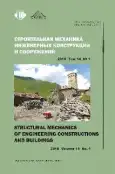TRANSFORMATION ELEMENT BETWEEN THE DEPENDENCE OF THE FRAC- TURE MECHANICS AND THE EQUATIONS OF THE REINFORCED CONCRETE THEORY IN THE CONDITIONS OF A COMPLEX RESISTANCE
- Authors: DEM'YANOV A.I1, YAKOVENKO I.A2, KOLCHUNOV V.I1
-
Affiliations:
- Southwest State University, Kursk, Russian Federation
- National Aviation University, Kiev, Ukraine
- Issue: Vol 14, No 1 (2018)
- Pages: 46-56
- Section: Analysis and design of building structures
- URL: https://journal-vniispk.ru/1815-5235/article/view/346358
- DOI: https://doi.org/10.22363/1815-5235-2018-14-1-46-56
- ID: 346358
Cite item
Full Text
Abstract
The hypothesis of fracture mechanics is developed in the article and a universal short dual-console element is designed for reinforced concrete structures of buildings and structures. The proposed dual-console element is applicable to the evaluation of reinforced concrete structures resistance under conditions of various force and deformation effects, including torsion with bending. Simplified dependences are constructed for the energy functional and the specifics and features of the construction of a dual-console fracture mechanics element in the zones adjacent to the spatial cracks are considered taking into account the discontinuity effect. The dual-console element is the connecting link and serves as a transformational element between the dependencies of fracture mechanics and the equations of reinforced concrete theory.
About the authors
ALEXEY I DEM'YANOV
Southwest State University, Kursk, Russian Federation
Author for correspondence.
Email: speccompany@gmail.com
Candidate of Technical Sciences, Associate Professor, Associate Professor of the Industrial and Civil Engineering Department Southwest State University, Kursk, Russia. Scientific interests: reinforced concrete structures of buildings and structures, resistance of reinforced concrete structures under the action torsion with bending.
Russian Federation, 50 let Oktyabrya Street, 94, Kursk, 305040, Russian FederationIGOR A YAKOVENKO
National Aviation University, Kiev, Ukraine
Email: i2103@ukr.net
Candidate of Technical Sciences, Associate Professor, Associate Professor of the Computer Technology of Construction Department National Aviation University, Kiev, Ukraine. Scientific interests: reinforced concrete structures of buildings and structures, reinforced concrete composite structures, reconstruction of buildings and structures, mechanics of destruction of reinforced concrete
Ukraine, Prosp. Kosmonavta Komarova, Kyiv, 03058, UkraineVLADIMIR I KOLCHUNOV
Southwest State University, Kursk, Russian Federation
Email: vlik52@mail.ru
Doctor of Technical Sciences, Professor, Professor of the Unique Buildings and Structures Department, Southwest State University, Kursk, Russia. Foreign member of RAASN. Scientific interests: reinforced concrete structures of buildings and structures, mechanics of reinforced concrete, reconstruction of buildings and structures, reinforced concrete composite structures
Russian Federation, 50 let Oktyabrya Street, 94, Kursk, 305040, Russian FederationReferences
- ACI Committee 446, Fracture Mechanics (1992). Bažant Z.P., ed. Fracture mechanics of concrete structures. Part I, State-of-Art Report. Elsevier Applied Science, London and New York: 1–140.
- Zaitsev, Yu.V. (1991). Destruction Mechanics for Builders. Moscow: Vysshaya Shkola publ. 288 p. (In Russ.).
- Golyshev, A.B., Kolchunov V.I. (2009). [Soprotivlenie zhelezobetona] Resistance of Reinforced Concrete. Kiev: Osnova publ. 432. (In Russ.).
- Kolchunov, V.I., Yakovenko, I.A. (2009). The development of dual console fracture mechanics element to calculate the width opening of cracks in reinforced concrete constructions. Bulletin of Civil En-gineers, 4 (21), 160—163. (In Russ.).
- Hillerborg, A., Modeer, M., and Petersson, P.E. (1976). Analysis of crack formation and crack growth in concrete by means of fracture mechanics and finite elements. Cement and Concrete Research, (6), 773—782.
- Klyuyeva, N.V., Kolchunov, V.I., Yakovenko, I.A. (2014). Problem development tasks of hy-potheses of mechanics of destruction as applied to analysis of reinforced concrete structures. News of the Kazan State University of Architecture and Engineering, 3 (29), 41—45. (In Russ.).
- Kolchunov, V.I., Yakovenko, I.A. (2016). About the violation solid effect of reinforced concrete in reconstruction design of textile industry enterprises. The News of Higher Educational Institutions. Tech-nology of Textile Industry, 3(363), 258—263. (In Russ.).
- Guder Dzh., Libovits G., Freidental A., Yhlynskii A.Y., ed. (1975). Razrushenie. T. 2. Ma-tematicheskie osnovy teorii razrusheniya [Destruction. Part 2: Mathematical fundamentals theory of destruction]. Moscow: Mir publ. 768. (In Russ.).
- Garba, M.O., Baranetsky, A.O., Yakovenko, I.A., Kolchunov, V.I. (2013). The resistance to the cracking of reinforced concrete structures under the action torsion with bending. Allplan CAD in Archi-tecture and Building, Kiev, the 22-26th of April 2013. Kiev: NAU publ. 54—59. (In Russ.).
- Dem’yanov, A.I., Kolchunov, V.I., Salnikov, A.S., Mikhailov, M.M. (2017). The calculation models of static-dynamic deformation of a reinforced concrete structure under the action torsion with bend-ing at the moment of spatial crack formation. Building and Reconstruction, 3 (71), 13—22. (In Russ.).
- Salnikov, A.S., Klyueva, N.V., Kolchunov, Vl.I. (2016). A method for determining the mini-mum load and the coordinates of the formation of a spatial crack in reinforced concrete structures with torsion with bending. Industrial and Civil Engineering, (1), 52—57. (In Russ.).
- Pokusaev, A.A., Shavykina, M.V., Kolchunov, V.I. (2016). Calculation of the distance between the spatial cracks and the width of their opening in reinforced concrete structures in torsion with a bend (case 1). Construction Mechanics and Calculation of Structures, 2 (265), 20–29. (In Russ.).
- Dem’yanov, A.I., Kolchunov, V.I., Yakovenko I.A. (2017). To the problem of dynamic rein-forcement after the instantaneous formation of a spatial crack in a reinforced concrete structure under the action torsion with bending. Industrial and Civil Engineering, (9), 56—62. (In Russ.).
- Rogers D., Adams J. (2001). Matematicheskie osnovy mashinnoi grafiki [Mathematical foun-dations of computer graphics]. Moscow, 605 p. (In Russ.).
- Bakhotsky I.V. (2013). Experimental-theoretical study of the stress-strain state of fiber-reinforced concrete elements subject to torsional influences with bending. Bulletin of Civil Engineers, 4 (39), 55—60. (In Russ.).
Supplementary files









